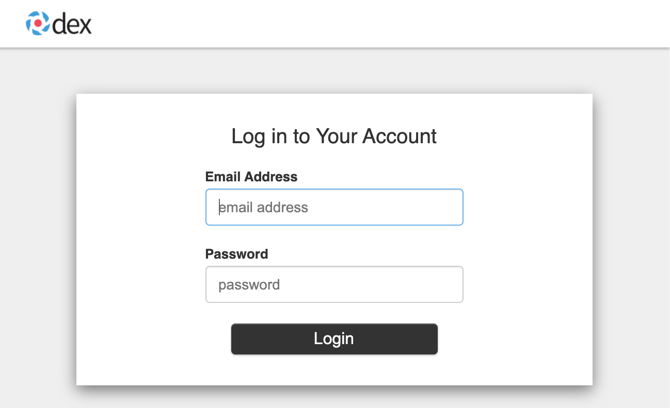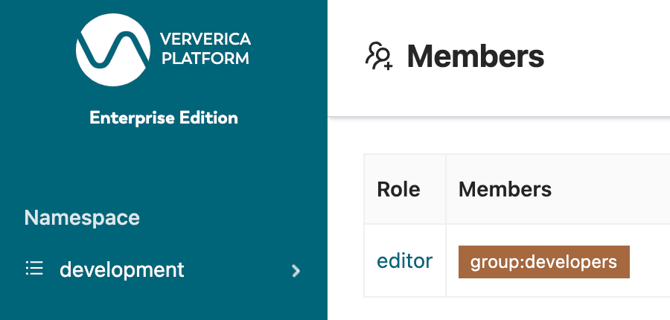How to setup RBAC in Ververica Platform using Dex & LDAP
Answer
Note: This section applies to Ververica Platform Stream Edition 2.0 and later.
Ververica Platform standalone does not support direct integration with LDAP for authentication and authorization. In order to achieve this, one would need a bridge that can translate OIDC requests to LDAP queries and connect the gap. Dex is an open-source OIDC provider that has a rich connector ecosystem. It can serve as a middleware to authenticate and authorize against LDAP servers.
Here are the steps to configure Ververica Platform to use Dex & LDAP for RBAC.
1) LDAP Deployment
In this article, we setup an OpenLDAP server in Kubernetes to show how the connectivity works between Dex and LDAP. If you have already a running LDAP server, note down your ldap server host and the listening port, then you can skip the rest of this section.
The LDAP setup consists of three parts: the LDAP configuration, the LDAP deployment, and the service so that the LDAP server is accessible by Dex. We have three users with each of them being a member of the three different groups named admins, developers, and operations.
configmap.yaml
apiVersion: v1
kind: ConfigMap
metadata:
name: ldap
namespace: auth
data:
config.ldif: |
dn: ou=People,dc=example,dc=org
objectClass: organizationalUnit
ou: People
# User definitions
dn: cn=admin,ou=People,dc=example,dc=org
objectClass: person
objectClass: inetOrgPerson
sn: doe
cn: admin
mail: admin@example.org
userpassword: password
dn: cn=jane,ou=People,dc=example,dc=org
objectClass: person
objectClass: inetOrgPerson
sn: doe
cn: jane
mail: jane@example.org
userpassword: foo
dn: cn=john,ou=People,dc=example,dc=org
objectClass: person
objectClass: inetOrgPerson
sn: doe
cn: john
mail: john@example.org
userpassword: bar
# Group definitions
dn: ou=Groups,dc=example,dc=org
objectClass: organizationalUnit
ou: Groups
dn: cn=admins,ou=Groups,dc=example,dc=org
objectClass: groupOfNames
cn: admins
member: cn=admin,ou=People,dc=example,dc=org
dn: cn=developers,ou=Groups,dc=example,dc=org
objectClass: groupOfNames
cn: developers
member: cn=jane,ou=People,dc=example,dc=org
dn: cn=operations,ou=Groups,dc=example,dc=org
objectClass: groupOfNames
cn: operations
member: cn=john,ou=People,dc=example,dc=org
deployment.yaml
apiVersion: apps/v1
kind: Deployment
metadata:
name: ldap
namespace: auth
spec:
replicas: 1
selector:
matchLabels:
app: ldap
template:
metadata:
labels:
app: ldap
spec:
containers:
- name: ldap
image: osixia/openldap:1.4.0
args: ["--copy-service"]
ports:
- containerPort: 389
env:
- name: LDAP_TLS_VERIFY_CLIENT
value: "try"
volumeMounts:
- name: config
mountPath: /container/service/slapd/assets/config/bootstrap/ldif/custom/config.ldif
subPath: config.ldif
volumes:
- name: config
configMap:
name: ldap
service.yaml
apiVersion: v1
kind: Service
metadata:
name: ldap
namespace: auth
spec:
selector:
app: ldap
ports:
- name: ldap
port: 389
protocol: TCP
Now you can run kubectl apply -f <yaml file> to get the LDAP server up and running at ldap.auth.svc:389 in your Kubernetes cluster.
2) Dex Deployment
Dex has many connectors available. Here, we configure Dex to use the LDAP connector to connect to our LDAP server. If you are using your own LDAP server, adapt config accordingly. We also register Ververica Platform as a static client with its redirect URL. The service is used by Ververica Platform to communicate with Dex.
Tip: Secure the secret information for the Ververica Platform client in a production environment, as well as the network communication. See Related Information for more information.
configmap.yaml
apiVersion: v1
kind: ConfigMap
metadata:
name: dex
namespace: auth
data:
config.yaml: |
issuer: http://dex.auth.svc:5556/dex
storage:
type: sqlite3
config:
file: /storage/dex.db
web:
http: 0.0.0.0:5556
oauth2:
responseTypes: ["code", "token"]
skipApprovalScreen: true
connectors:
- type: ldap
name: Example LDAP
id: ldap
config:
host: ldap.auth.svc:389
insecureNoSSL: true
bindDN: cn=admin,dc=example,dc=org
bindPW: admin
usernamePrompt: Email Address
userSearch:
baseDN: ou=People,dc=example,dc=org
filter: "(objectClass=person)"
username: mail
idAttr: DN
emailAttr: mail
nameAttr: cn
groupSearch:
baseDN: ou=Groups,dc=example,dc=org
filter: "(objectClass=groupOfNames)"
userMatchers:
- userAttr: DN
groupAttr: member
nameAttr: cn
staticClients:
- id: vvp
name: 'Ververica Platform'
secret: hJQ8kTtZoDZKWIoX9lx7a4JK81LQ4DCB
redirectURIs:
- 'http://ververica-platform.vvp.svc:8080/login/oauth2/code/dex'
deployment.yaml
apiVersion: apps/v1
kind: Deployment
metadata:
name: dex
namespace: auth
spec:
replicas: 1
selector:
matchLabels:
app: dex
template:
metadata:
labels:
app: dex
spec:
containers:
- name: dex
image: ghcr.io/dexidp/dex:v2.30.2
command: ["dex"]
args: ["serve", "/etc/dex/config.yaml"]
ports:
- containerPort: 5556
volumeMounts:
- name: config
mountPath: /etc/dex/config.yaml
subPath: config.yaml
- name: storage
mountPath: /storage
volumes:
- name: config
configMap:
name: dex
- name: storage
emptyDir: {}
service.yaml
apiVersion: v1
kind: Service
metadata:
name: dex
namespace: auth
spec:
selector:
app: dex
ports:
- name: dex
port: 5556
protocol: TCP
Similarly, you can run kubectl apply -f <yaml file> to get the Dex server up and running at dex.auth.svc:5556 in your Kubernetes cluster.
3) VVP Configuration
Finally, we add the auth part to point to our Dex deployment. The issuerUri configuration is enough for Ververica Platform to resolve available common OIDC request endpoints. We are also setting the admins of the Ververica Platform to be the users that are members of the group named admins.
Tip: Some of the OIDC request endpoints are only for application to application communication, whereas some of the endpoints are meant for public access to an end-user, such as redirect and authorization URI's. Explicitly specify internal and external DNS names for OIDC request endpoints accordingly to optimize the network costs.
vvp:
auth:
enabled: true
admins:
- group:admins
oidc:
groupsClaim: groups
registrationId: dex
registration:
clientId: vvp
clientSecret: hJQ8kTtZoDZKWIoX9lx7a4JK81LQ4DCB
authorizationGrantType: authorization_code
redirectUri: "{baseUrl}/{action}/oauth2/code/{registrationId}"
clientAuthenticationMethod: basic
scope:
- openid
- groups
provider:
issuerUri: http://dex.auth.svc:5556/dex
userNameAttribute: email
Note: please use the redirectUri above literally as it is, Ververica Platform takes care of the placeholder substatution automatically.
4) RBAC Configuration
Now that Ververica Platform is set to use Dex for RBAC, all the unauthenticated page requests will be redirected to Dex's login page.

After the user credentials that are stored in LDAP are entered, it will redirect the requester back to the Ververica Platform. Admins of Ververica Platform can then set up RBAC using the user and/or group information retrieved from the LDAP server via Dex.

